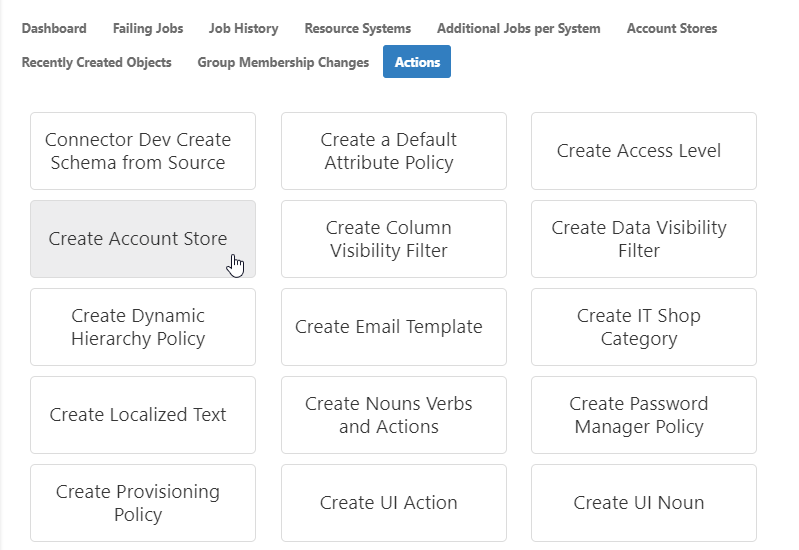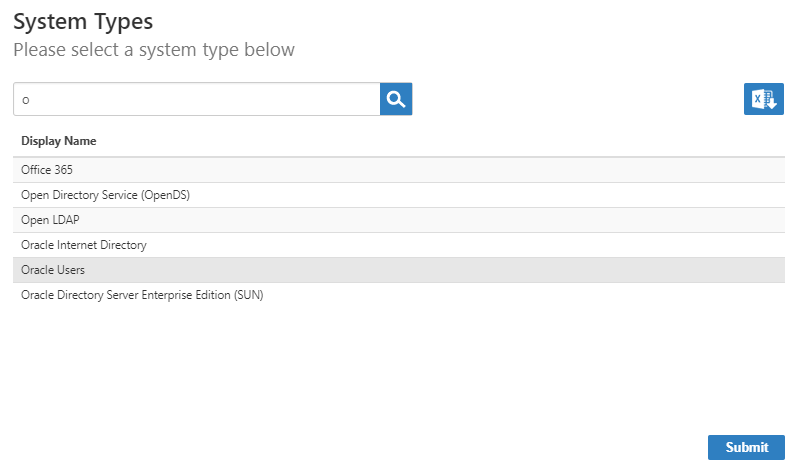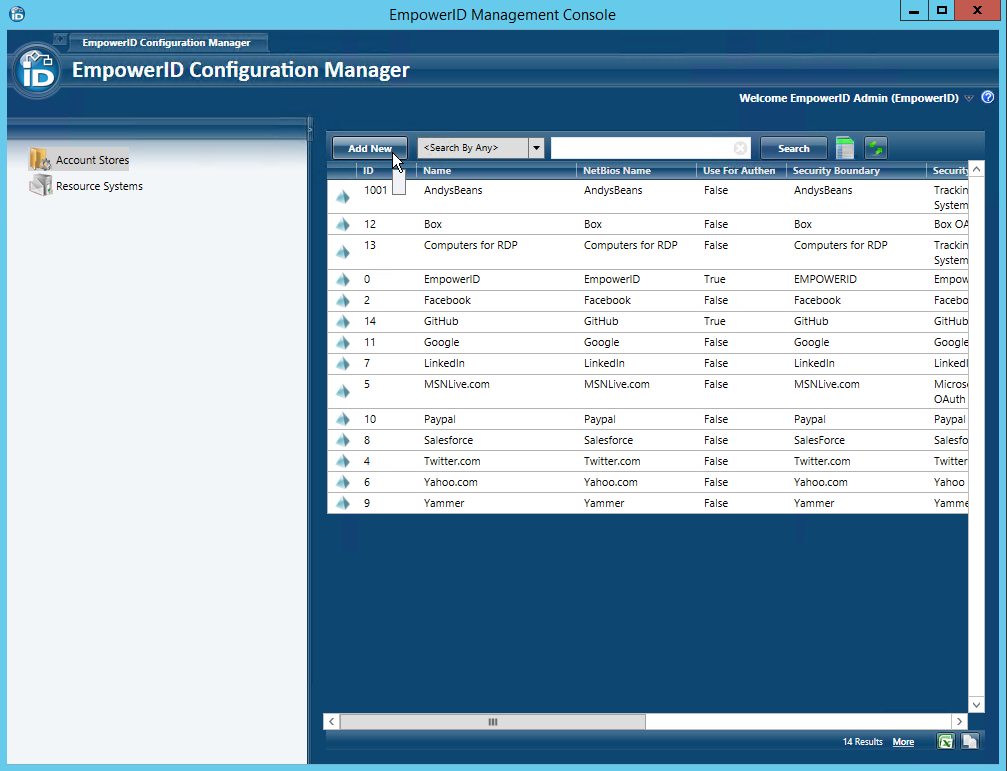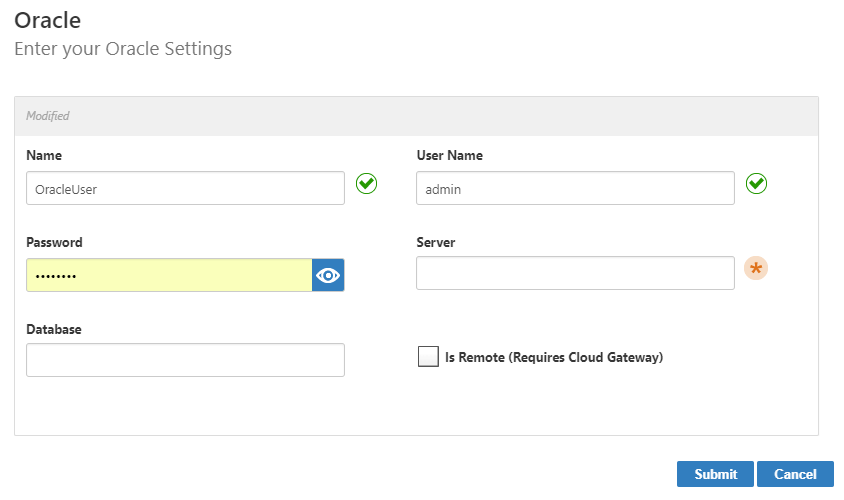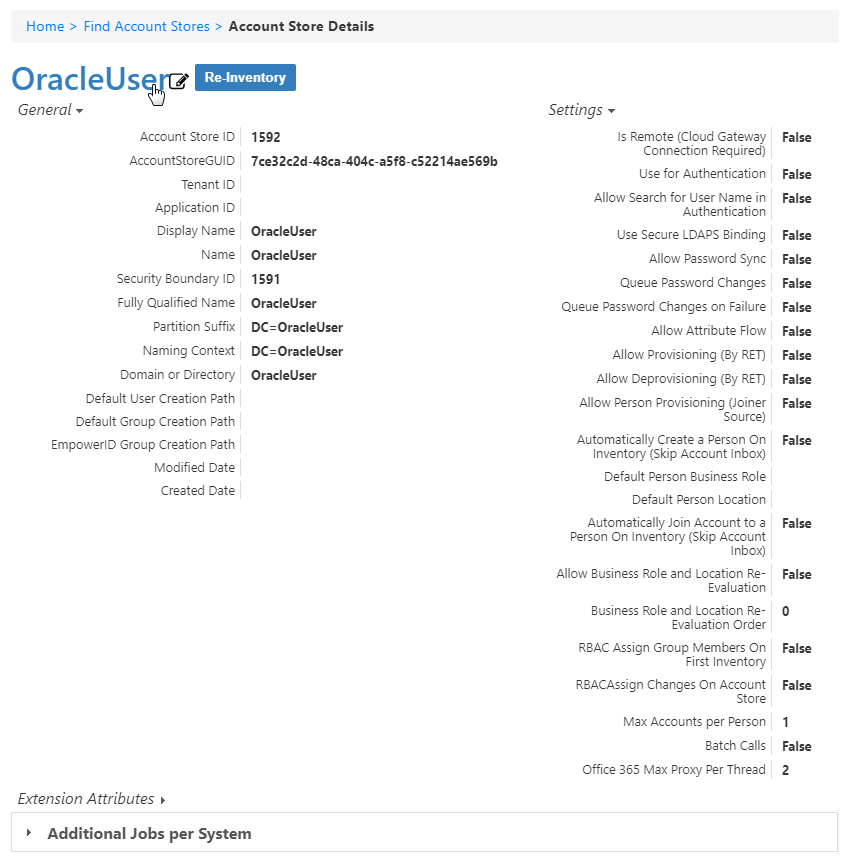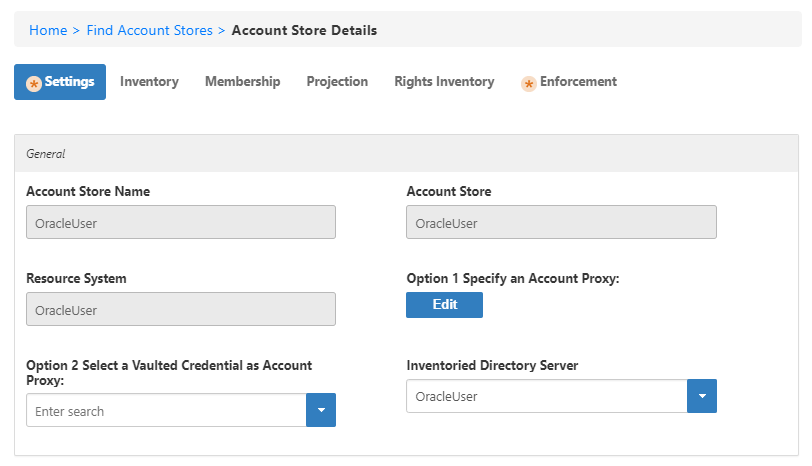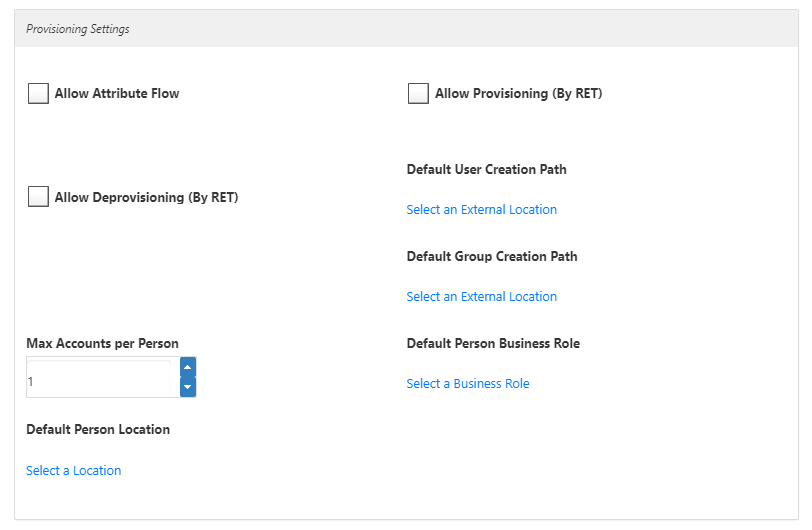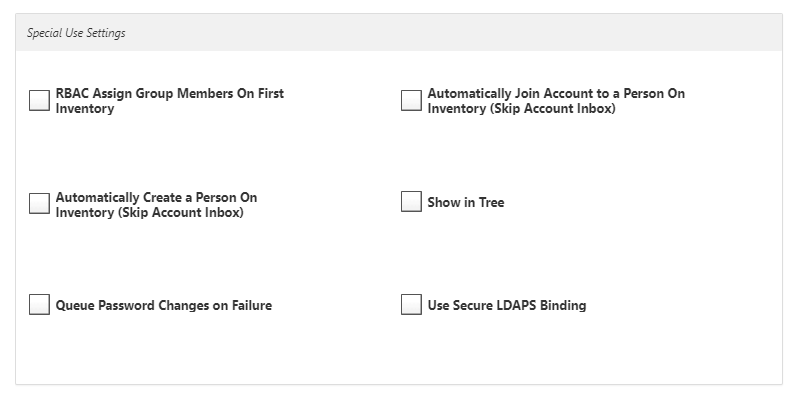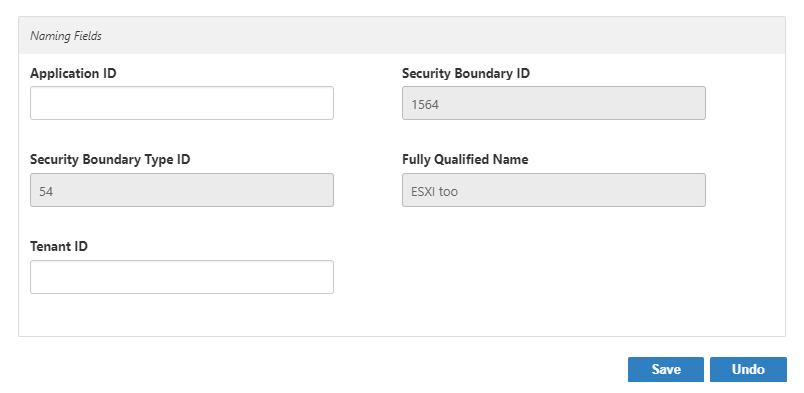Inventory TabThe Inventory tab is where you set scheduling and enable EmpowerID to take inventory of the external system. If you do not want all of the users and groups found during inventory to go in the same location in EmpowerID, we recommend Mapping EmpowerID Locations to External Locations before enabling inventory. | Setting | Description |
|---|
| Inventory Enabled | Select this after everything is set up to your liking to allow EmpowerID to inventory the system. The Inventory Job must be enabled for inventory to occur. | | Inventory Schedule Interval: Start | Set the date on which to begin inventorying the system. By default, this is set to the creation date of the account store. | | Inventory Schedule Interval: End | Set the date on which to stop inventorying the system. By default, this is set to ten years after the creation date of the account store, but since Run Indefinitely is selected by default, this value is ignored unless you clear that checkbox. | | Inventory Schedule Interval: (units) | Select the units for the interval at which to run inventory. By default, this is set to 10 minutes. - Once — If you select this value, the Interval box below is replaced with a Times control that allows you to specify the time at which to run inventory.
- Hour Interval — If you select this value, enter the number of hours between inventory runs in the Interval box below.
- Weekly — If you select this value, the Interval box below is replaced with a Times control that allows you to specify the day and time at which to run inventory.
- Minute Interval — If you select this value, enter the number of minutes between inventory runs in the Interval box below.
- Daily — If you select this value, the Interval box below is replaced with a Times control that allows you to specify the time at which to run inventory each day.
- Monthly — If you select this value, the Interval box below is replaced with a Times control that allows you to specify the months, days, and time at which to run inventory.
| | Run Indefinitely | Select to allow inventory to run indefinitely, ignoring the End date. | | Interval: (number) | Set the number of units for the interval at which to run inventory. By default, this is set to 10 minutes. | | Inventory Next Compilation Time | If you do not want to wait for the next regularly scheduled inventory run, specify the time and date to run it next. | | Inventory Batch Size | Specify the number of records to process in each batch, to avoid hanging up your system when large numbers of records are processed. By default, this is set to 1,000 records. |
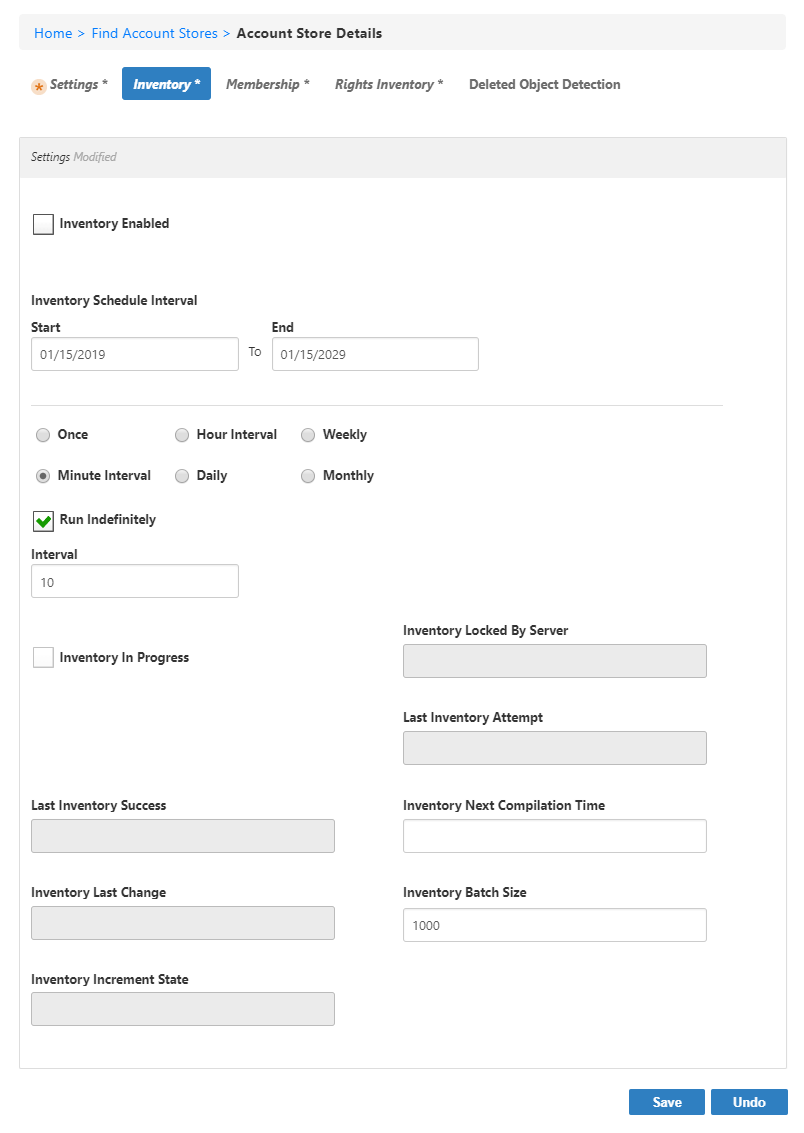 Image Added Image Added
Membership TabGroup membership reconciliation is enabled by default to run every ten minutes, indefinitely. | Setting | Description |
|---|
| Enable Group Membership Reconciliation | Select to allow EmpowerID to reconcile group membership with the system. This is enabled by default. | | Membership Schedule Interval: Start | Set the date on which to begin reconciling group membership with the system. By default, this is set to the creation date of the account store. | | Membership Schedule Interval: End | Set the date on which to stop reconciling group membership with the system. By default, this is set to ten years after the creation date of the account store, but since Run Indefinitely is selected by default, this value is ignored unless you clear that checkbox. | | Membership Schedule Interval: (units) | Select the units for the interval at which to run inventory. By default, this is set to 10 minutes. - Once — If you select this value, the Interval box below is replaced with a Times control that allows you to specify the time at which to run reconciliation.
- Hour Interval — If you select this value, enter the number of hours between reconciliation runs in the Interval box below.
- Weekly — If you select this value, the Interval box below is replaced with a Times control that allows you to specify the day and time at which to run reconciliation.
- Minute Interval — If you select this value, enter the number of minutes between reconciliation runs in the Interval box below.
- Daily — If you select this value, the Interval box below is replaced with a Times control that allows you to specify the time at which to run reconciliation each day.
- Monthly — If you select this value, the Interval box below is replaced with a Times control that allows you to specify the months, days, and time at which to run reconciliation.
| | Run Indefinitely | Select to allow group membership reconciliation to run indefinitely, ignoring the End date. | | Interval: (number) | Set the number of units for the interval at which to run rights inventory. By default, this is set to 10 minutes. |
 Image Added Image Added
Projection TabThe Projection tab is where you set scheduling and enable EmpowerID to sync resource role group membership with the account store. | Setting | Description |
|---|
| Resource Role Group Membership Projection Enabled | Select to allow EmpowerID to dynamically manage the membership of the organization's groups, adding and removing users to and from groups based on policy-based assignment rules. This is disabled by default. | | Rights Inventory Schedule Interval: Start | Set the date on which to begin projection. By default, this is set to the creation date of the account store. | | Rights Inventory Schedule Interval: End | Set the date on which to stop projection. By default, this is set to ten years after the creation date of the account store, but since Run Indefinitely is selected by default, this value is ignored unless you clear that checkbox. | | Rights Inventory Schedule Interval: (units) | Select the units for the interval at which to run projection. By default, this is set to 10 minutes. - Once — If you select this value, the Interval box below is replaced with a Times control that allows you to specify the time at which to run projection.
- Hour Interval — If you select this value, enter the number of hours between projection runs in the Interval box below.
- Weekly — If you select this value, the Interval box below is replaced with a Times control that allows you to specify the day and time at which to run projection.
- Minute Interval — If you select this value, enter the number of minutes between projection runs in the Interval box below.
- Daily — If you select this value, the Interval box below is replaced with a Times control that allows you to specify the time at which to run projection each day.
- Monthly — If you select this value, the Interval box below is replaced with a Times control that allows you to specify the months, days, and time at which to run projection.
| | Run Indefinitely | Select to allow projection to run indefinitely, ignoring the End date. | | Interval: (number) | Set the number of units for the interval at which to run projection. By default, this is set to 10 minutes. | | Inventory Next Compilation Time | If you do not want to wait for the next regularly scheduled projection run, specify the time and date to run it next. |
 Image Added Image Added
Rights Inventory TabThe Rights Inventory tab is where you set scheduling and enable EmpowerID to take inventory of rights in the native system. | Setting | Description |
|---|
| Rights Inventory Is Enabled | Select to allow EmpowerID to inventory native rights in the system. This is disabled by default. | | Rights Inventory Schedule Interval: Start | Set the date on which to begin inventorying rights in the system. By default, this is set to the creation date of the account store. | | Rights Inventory Schedule Interval: End | Set the date on which to stop inventorying rights in the system. By default, this is set to ten years after the creation date of the account store, but since Run Indefinitely is selected by default, this value is ignored unless you clear that checkbox. | | Rights Inventory Schedule Interval: (units) | Select the units for the interval at which to run rights inventory. By default, this is set to 10 minutes. - Once — If you select this value, the Interval box below is replaced with a Times control that allows you to specify the time at which to run rights inventory.
- Hour Interval — If you select this value, enter the number of hours between rights inventory runs in the Interval box below.
- Weekly — If you select this value, the Interval box below is replaced with a Times control that allows you to specify the day and time at which to run rights inventory.
- Minute Interval — If you select this value, enter the number of minutes between rights inventory runs in the Interval box below.
- Daily — If you select this value, the Interval box below is replaced with a Times control that allows you to specify the time at which to run rights inventory each day.
- Monthly — If you select this value, the Interval box below is replaced with a Times control that allows you to specify the months, days, and time at which to run rights inventory.
| | Run Indefinitely | Select to allow rights inventory to run indefinitely, ignoring the End date. | | Interval: (number) | Set the number of units for the interval at which to run rights inventory. By default, this is set to 10 minutes. | | Inventory Next Compilation Time | If you do not want to wait for the next regularly scheduled rights inventory run, specify the time and date to run it next. |
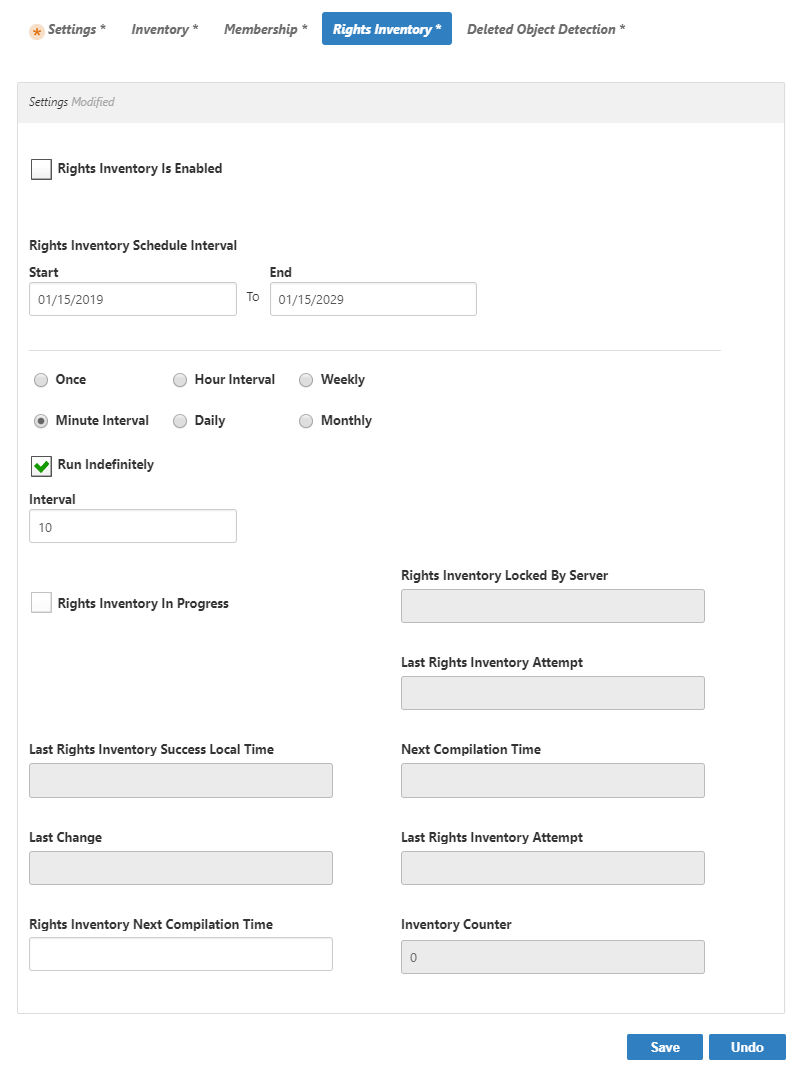 Image Added Image Added
Enforcement Tab
| Setting | Description |
|---|
| Resource Role Group Rights Enforcement Enabled | Select to allow EmpowerID to determine who should have access to what in Exchange based on their assignments to Access Levels in EmpowerID and to enforce it using domain local groups (Resource Role Groups). | | Enforcement Type | Select to specify how EmpowerID is to enforce rights in native systems. - No Action — No rights enforcement action occurs.
- Projection with Enforcement — Changes to rights within EmpowerID occur within EmpowerID and are enforced within the native environment.
- Projection with No Enforcement — Changes to rights within EmpowerID occur only within EmpowerID; they are not passed on to the native environment.
- Projection with Strict Enforcement — EmpowerID overrides any changes made in the native environment. All changes made must occur within EmpowerID to be accepted. (Applies only to Active Directory groups.)
| | Schedule: Start | Set the date on which to begin enforcement. By default, this is set to the creation date of the account store. | | Schedule: End | Set the date on which to stop enforcement. By default, this is set to ten years after the creation date of the account store, but since Run Indefinitely is selected by default, this value is ignored unless you clear that checkbox. | | Interval: (units) | Select the units for the interval at which to run enforcement. By default, this is set to 10 minutes. - Once — If you select this value, the Interval box below is replaced with a Times control that allows you to specify the time at which to run enforcement.
- Hour Interval — If you select this value, enter the number of hours between enforcement runs in the Interval box below.
- Weekly — If you select this value, the Interval box below is replaced with a Times control that allows you to specify the day and time at which to run enforcement.
- Minute Interval — If you select this value, enter the number of minutes between enforcement runs in the Interval box below.
- Daily — If you select this value, the Interval box below is replaced with a Times control that allows you to specify the time at which to run enforcement each day.
- Monthly — If you select this value, the Interval box below is replaced with a Times control that allows you to specify the months, days, and time at which to run enforcement.
| | Run Indefinitely | Select to allow enforcement to run indefinitely, ignoring the End date. | | Interval: (number) | Set the number of units for the interval at which to run enforcement. By default, this is set to 10 minutes. | | Enforcement Frequency | Set the re-enforcement frequency in minutes. |
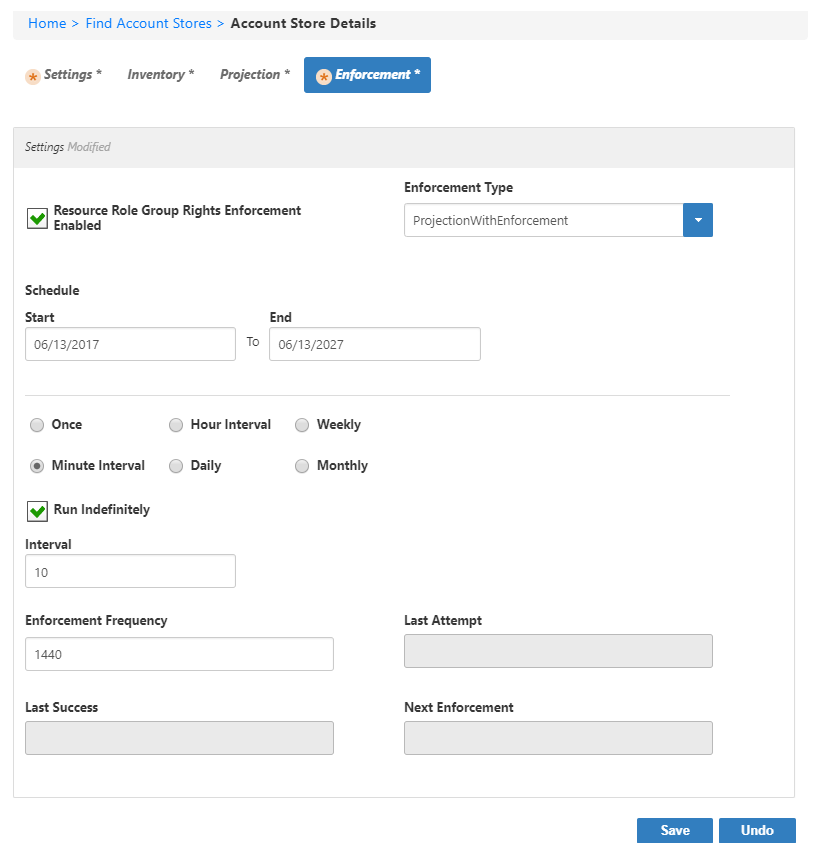 Image Added Image Added
|
